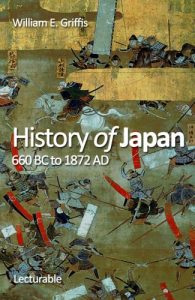From the beginning of the Japanese empire, until the century after the introduction of Buddhism, the mikados were the real rulers of their people, having no hedge of division between them and their subjects. The palace was not secluded from the outer world. No screen hid the face of the monarch from the gaze of his subjects. No bureaucracy rose, like a wall of division, between ruler and ruled. No hedge or net of officialdom hindered free passage of remonstrance or petition. The mikado, active in word and deed, was a real ruler, leading his armies, directing his Government. Those early days of comparative national poverty when the mikado was the warrior-chief of a conquering tribe; and, later, when he ruled a little kingdom in Central Japan, holding the distant portions of his quasi-empire in tribute; and, still later, when he was the head of an undivided empire - mark the era of his personal importance and energy. Then, in the mikado dwelt a manly soul, and a strong mind in a strong body. This era was the golden age of the imperial power. He was the true executive of the nation, initiating and carrying out the enterprises of peace or war. As yet, no military class had arisen to make themselves the arbiters of the throne; as yet, that throne was under no proprietorship; as yet, there was but one capital and center of authority.
Contents: The Background. The Aborigines. Materials of History. Japanese Mythology. The Twilight of Fable. Sūjin, the Civilizer. Yamato-daké, the Conqueror of the Kuanté. The Introduction of Continental Civilization. Life in Ancient Japan. The Ancient Religion. The Throne and the Noble Families. The Beginning of Military Domination. Yoritomo and the Minamoto Family. Creation of the Dual System of Government. The Glory and the Fall of the Hōjō Family. Buddism in Japan. The Invasion of the Mongol Tartars. The Temporary Mikadoate. The War of the Chrysanthemums. The Ashikaga Period. Life in the Middle Ages. The Growth and Customs of Feudalism. Nobunaga, the Persecutor of the Buddhists. Hidéyoshi's Exterprises. The Invasion Of Corea. Christianity and Foreigners. Iyeyasu, the Founder of Yedo. The Perfection of Duarchy and Feudalism. The Recent Revolutions in Japan.
Contents: The Background. The Aborigines. Materials of History. Japanese Mythology. The Twilight of Fable. Sūjin, the Civilizer. Yamato-daké, the Conqueror of the Kuanté. The Introduction of Continental Civilization. Life in Ancient Japan. The Ancient Religion. The Throne and the Noble Families. The Beginning of Military Domination. Yoritomo and the Minamoto Family. Creation of the Dual System of Government. The Glory and the Fall of the Hōjō Family. Buddism in Japan. The Invasion of the Mongol Tartars. The Temporary Mikadoate. The War of the Chrysanthemums. The Ashikaga Period. Life in the Middle Ages. The Growth and Customs of Feudalism. Nobunaga, the Persecutor of the Buddhists. Hidéyoshi's Exterprises. The Invasion Of Corea. Christianity and Foreigners. Iyeyasu, the Founder of Yedo. The Perfection of Duarchy and Feudalism. The Recent Revolutions in Japan.












